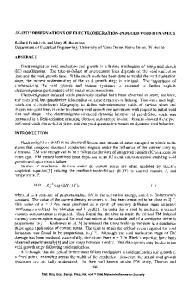In Situ observations of the gaseous reduction of magnetite
- PDF / 4,430,829 Bytes
- 11 Pages / 603.28 x 783.28 pts Page_size
- 99 Downloads / 336 Views
I.
INTRODUCTION
THE direct
observation of the decomposition of solids enables a continuous record of the microstructural changes on the surface to be obtained. Direct or in situ techniques thus offer considerable advantages over indirect techniques in characterizing the mechanisms and kinetics of such reactions, although experimentally they are more difficult to carry out. Optical microscopy, EI-91 scanning electron microscopy, t~~ and transmission electron microscopy, t14,15,16]have all been used to study the hightemperature reduction of iron oxides. The choice of technique depends primarily on the scale of the phenomena under investigation and the type of information which is being sought, i.e., microstructural changes or kinetic measurements. Earlier work by Pluschkell and Sarma ~51has shown that optical microscopy is particularly useful-in studying the gaseous reduction of magnetite. Using a H2/N2 gas mixture containing a hydrogen partial pressure of (13 kPa) 98 torr, information was obtained on the structural changes occurring on the oxide surfaces and the kinetics of the reactions. Three distinct structural forms of the iron nuclei were observed: a low-temperature form (T < 793 K), which had an extensive micropore system and large radial fissures; a medium-temperature form (793 < T < 893 K), which had a similar micropore system but without the radial fissures; and a high-temperature form (T > 893 K), which had a concentric macropore system but very few micropores. No significant dependence of the growth rates of these nuclei upon crystallographic direction was noted. Subsequent internal examination revealed a further difference between the product microstructures formed above and below 873 K, in that at lower temperatures, the reduction proceeded in a topochemical manner but, at higher temperatures, retained wustite was present. There was also a significant difference between the high- and low-temperature growth mechanisms, in that at temperatures below 873 K, the iron phase grew linearly with time, whereas at higher temperatures, it grew in discontinuous bursts. The periodic halts in the prog-
P.C. HAYES, Reader in Extractive Metallurgy, is with the Department of Mining and Metallurgical Engineering, University of Queensland, St. Lucia, Queensland 4067, Australia. S.P. MATII-IEW, formerly with the University of Queensland, is Research Metallurgist with the Process Development Group, Mount Isa Mines Ltd., Mr. Isa, Queensland, Australia. Manuscript submitted January 17, 1989. METALLURGICAL TRANSACTIONS B
ress of the metal phase at these higher temperatures were due to cracks between the metal and oxide phases and resulted in a corresponding reduction in the average growth rates. A minimum growth rate was found to occur at about 1023 K.
II.
EXPERIMENTAL
Dense magnetite samples were prepared by the oxidation of pressed, spectrographically pure iron pellets (2-mm thickness) in controlled CO/CO2 gas mixtures. The procedure for making the iron pellets has been described in a previous publication, t171 Three
Data Loading...











